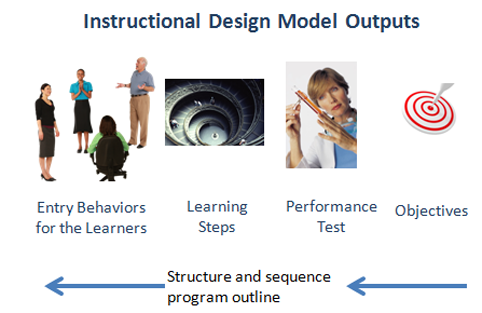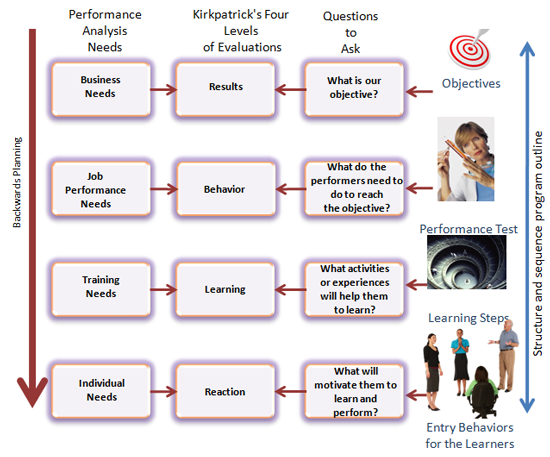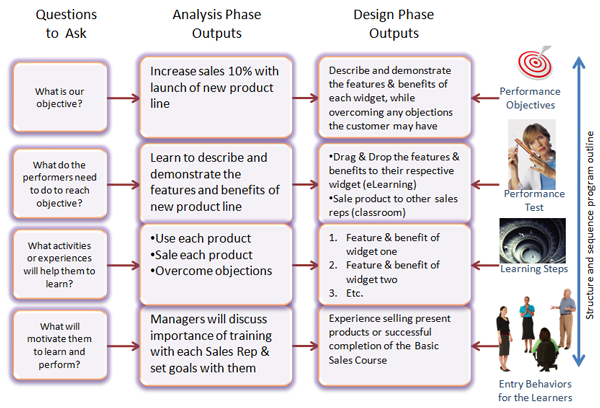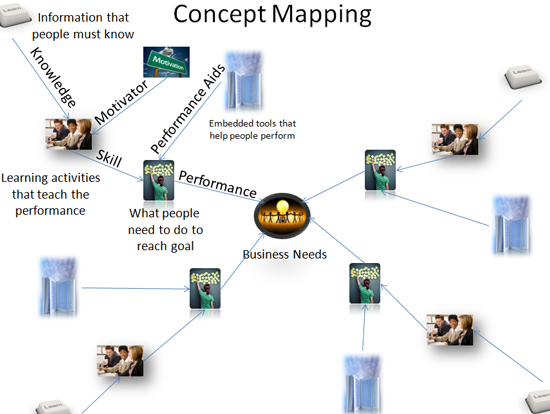Note: This site is moving to KnowledgeJump.com. Please reset your bookmark.
Design Phase
This phase insures the systematic development of the learning process. It is driven by the products of the analysis phase and ends in a model or blueprint of the learning process for future development. The model or blueprint should contain at least five key outputs:

- The learning objectives spell out the tasks the learners will be able to perform after they finish the learning process.
- The performance test requires the learners to perform the task or activity to standards.
- The learning or performance steps show how to perform a task. If the performance is mostly cognitive in nature, then use Cognitive Task Analysis.
- The entry behaviors describe what the learners must know before entering the training process. Just as a college requires certain standards to be met in order to enroll, a learning process should require a basic level of knowledge, skills, and attitudes (KSA).
- Finally, the learning process is sequenced and structured in an orderly fashion to provide the best opportunity for learning that will lead to performance.
Backwards Design Planning
Note how this design process builds on the outputs of the Backwards Planning Model that was captured in the Analysis Phase:

Click for larger image
The model below shows an example of linking the analysis outputs with the design outputs:

Click for larger image
Mapping the Design
The backwards planning model can also be shown with a Concept or Mind Map that allows you to show several performance requirements (known as “branches”). The example below shows four branches to meet the business need or objective. Note that when you complete one branch, you can add other branches to it. This mapping process allows you to show the program outline in a visual manner.

Click for larger image
Each branch should identify the:
-
Required performance
-
Learning activities that teach the performance
-
Information the learners must know in order to perform
-
Performance aids that will make the learning of new skills easier
The concept map shown below is an example for increasing sales:

Click for larger image
This concept map is similar to the one that Cathy Moore has in her excellent slide presentation that she calls Action Mapping.
The basic instructional outline and requirements captured in the Design Phase are then fleshed out in the Development Phase and by using other Instructional Design techniques.
Design Resources
These resources will help you to understand the design process:
-
Depending upon the complexity of the design, a different design approach or model may be used
-
If you are stuck, Ideas Favor the Connected Mind
There are no better terms available to describe the difference between the approach of the natural and the social sciences than to call the former “objective” and the latter “subjective”... While for the natural scientist the contrast between objective facts and subjective opinions is a simple one, the distinction cannot as readily be applied to the object of the social sciences. The reason for this is that the object, the “facts” of the social sciences are also opinions — not opinions of the student of the social phenomena, of course, but opinions of those whose actions produce the object of the social scientist. - The Counter-Revolution of Science by Friedrich August Von Hayek.
Next Steps
Go to the next section: Develop Objectives
Return to the Table of Contents
References
U.S. Army Field Artillery School (1984). A System Approach To Training (Course Student textbook). ST - 5K061FD92
U.S. Department of Defense Training Document (1975). Pamphlet 350-30. August, 1975.
